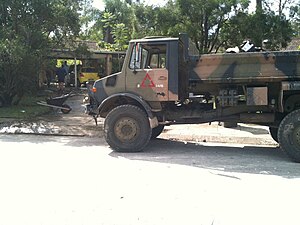|
Operation Queensland Flood Assist
Operation Queensland Flood Assist was a complex, multi-Service activity by the Australian Defence Force (ADF) as a contribution to the response to the 2010–2011 Queensland floods. Coordinated to aid civilian emergency response efforts, at Federal inter-departmental level it was managed by Emergency Management Australia. It comprised units and personnel from the Royal Australian Navy (RAN), Australian Army, and Royal Australian Air Force (RAAF) operating as Joint Task Force 637 (JTF 637). The operation was initially commanded by Colonel Luke Foster, based at Enoggera Barracks in Brisbane.[1] When the ADF commitment was increased, command was transferred to Brigadier Paul McLachlan, Commander of the 7th Brigade, also based in Brisbane.[2] Task force activities were coordinated with the civilian Queensland Recovery and Reconstruction taskforce headed by Major-General Michael Slater.[3] ActivitiesJTF 637 was established on 1 January 2011 to command the ADF units responding to the floods. At this time, these units included three Army Black Hawk helicopters, which were operating near the town of Emerald.[4] Additional ADF units were assigned to the task force as the situation worsened, and by 14 January, the task force comprised:[1]
On 13 January, ADF units assigned to JTF 637 were operating from Brisbane, Rockhampton, Townsville, RAAF Base Amberley, Roma, Theodore, St George and the Lockyer Valley.[1] On 14 January, Prime Minister Julia Gillard announced that the number of ADF personnel deployed would be increased to 1200, making it the largest deployment for a natural disaster since Cyclone Tracy in 1974.[6] The additional deployment would include the 2nd Combat Engineer Regiment and a Navy minehunter.[7] By 18 January the number of defence personnel deployed had risen to 1600. On the same day, minehunter HMAS Huon and hydrographic survey ships HMAS Paluma and HMAS Shepparton commenced surveying Moreton Bay and the Brisbane River for submerged debris.[8] Search and recovery operations in the Lockyer Valley continued into late January 2011. Maritime survey of the Brisbane River and Moreton Bay shipping channels and cleanup in the Grantham and Lockyer Valley continued into February 2011. JTF 637 was disestablished on 4 February, although Army engineers and Navy survey ships continued to provide support. Some of the assets were redeployed to Operation Yasi Assist. See alsoReferences
|
||||||||||||||||||
